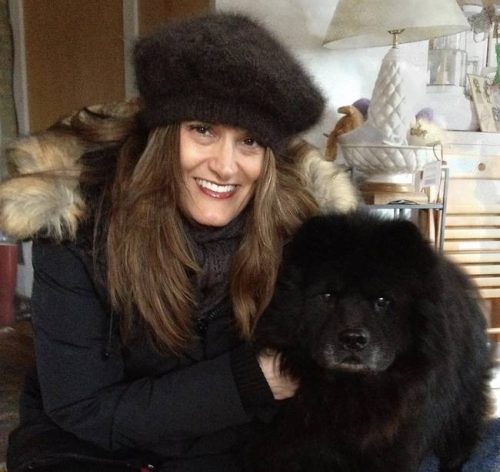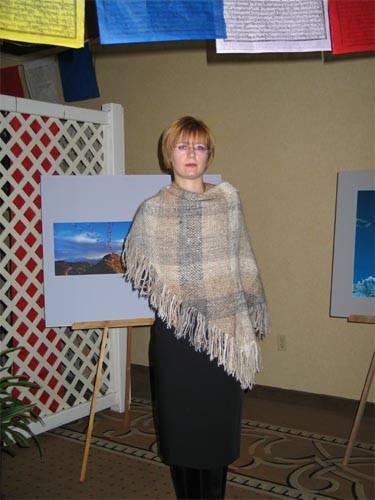
Very soon, spring will officially be upon us, and for many you, this means a spring shedding also known as “dog hair as a condiment.” Take our advice now: Don’t waste that hair!
Chiengora (pronounced she-an-gora) is yarn spun from dog hair (chien is the French word for dog, and gora is derived from “angora” the soft fur of a rabbit).
Spinning dog hair is old. Really old. This ancient art form that dates back to pre-historic Scandinavia was the main fiber spun on the North American continent before the Spaniards introduced sheep. The Salish, indigenous North Americans who lived in the Pacific Northwest, were famous for their blankets made from dog hair. These ancient Scandinavians and Salish were onto something. Chiengora wool can be up to eight times warmer than sheep wool because dog hairs have a hollow core that acts like insulation. It neither crimps nor barbs like sheep wool (which has little barbs that catch on each other), so there’s no stretch or shrinkage.

A merino shawl made of a blend of Lhasa Apso hair and wool. Photo shared by Vickie Kuhlmann
Before you freak out the dog out by eyeballing her in a maniacal Jack Nicholson “I’m Back” kind of way, there are a few things you should know:
Not all dog hair can be spun. In general, the hair of double coated breeds like Samoyeds, Bearded and Rough Collies, Shepherds, Newfoundlands, Kuvasz,Keeshonden, Afghans, Lhasa Apso, Bernese, Pekingese, Briards, Chow Chows, Siberian Huskies, and Great Pyrenees are good candidates; undercoat from any dual coated breed is always best, and that means that hair must be combed, brushed or plucked off the dog in order to minimize the undesirable part – the long, (usually) straight guard hairs. Cut or clipped hair is usually a poor candidate for spinning, and dogs with coats like Labs or Terriers are typically not great candidates.
Dog hair usually needs to be mixed with sheep wool in order to be made into yarn. If someone tries to make yarn from 100% dog hair and it’s not the undercoat from a dual-coated breed, the resulting yarn might resemble steel wool. Also dog hair has to come from a clean dog. The hair goes through a lengthy process to prepare it for knitting. It’s washed multiple times to get rid of any wet dog smell (merino sweaters don’t smell like a sheep, and a cashmere sweater doesn’t smell like a goat); Next, it’s “carded” to align the fibers, then spun into yarn, and finally, knitted or crocheted into a design.
Heads up if you’re in New Jersey. In the year 2000, the Governor of New Jersey signed into law Bill S-1815 that prohibited the sale of dog or cat fur and products made from it.
“Be It Enacted by the Senate and General Assembly of the State of New Jersey:
1. (New section) 1[a. No person may sell or barter or offer] Any person who sells, barters, or offers1 for sale or barter, at wholesale or retail, the fur or hair of a 1domestic1 dog or cat or any product made in whole or in part from the fur or hair of a 1domestic1 dog or cat 1[, except that this prohibition] commits a crime of the fourth degree, provided that the person knew or reasonably should have known that the fur or hair was from a domestic dog or cat or that the product was made in whole or in part from the fur or hair of a domestic dog or cat. This section1 shall not apply to the sale or barter 1, or offering for sale or barter,1 of the fur or hair of a 1domestic1 dog or cat cut at a commercial grooming establishment or at a veterinary office or clinic or for scientific research purposes.”
If you’re not in New Jersey, read on.
Dog yarn is said to feel like mohair, but more lightweight and more soft. About an 1 ounce of dog hair is enough to make a bookmark, ear warmer, headband, hair scrunchie, shoe laces, decorative flowers, hearts, sachets, or even an entire skein of yarn. There are a lot of sources to help you out including, “Knitting With Dog Hair: Better A Sweater From A Dog You Know and Love Than From A Sheep You’ll Never Meet.” There are also professionals who can take your wool and make it into yarn, including Knit Your Dog and Kaidi Visk, a craftsman from Estonia whose Facebook page is here. Costs vary. A reasonable estimate is $1-3 per yard of finished yarn. A 100 yard hank of best, clean dog undercoat could cost at least $100, and if it has to be washed and have wool added, etc, the price goes up.
NPDD likes to support its own. If you are an independent craftsman who spins or knits with dog wool, and you’re accepting commissions,or you have a business that converts dog hair into yarn, feel free to list your contact information on the space below (NOT on Facebook)
Don’t drink a hair of the dog. Wear it!
We believe the photo of the woman in the beret with the black Chow Chow is Ellie Jamonts from Knit Your Dog, Inc. We’re told the photo was taken by the company owner.

The photo of the woman in the beret with the black Chow Chow is from Knit Your Dog, Inc. and can be found on the Etsy shop KnitYourDog. The photo was taken by the company owner.